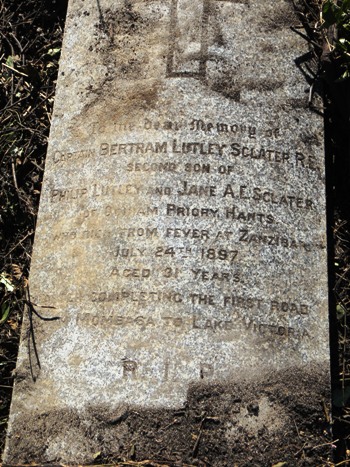View entry
Name: SCLATER, Bertram Lutley (Capt. RE)

Photo Source: Kevin Patience
Nee: son of Philip Lutley Sclater and Jane
Birth Date: 22.2.1866 Kensington, London
Death Date: 24.7. 1897 Zanzibar, blackwater fever
First Date: about 1895
Last Date: 1897
Profession: Appointed to extend the up-country road from Kibwezi into Highlands of EA, which he did with great skill. Road leading from Westlands through Kabete and Kikuyu bore his name.
Married: Unmarried
Book Reference: Gillett, Hobley, Permanent Way, Moyse, North, Nicholls, Chandler, Kenya Past & Present, Mills Railway
War Service: Royal Engineers
General Information:
Permanent Way - 'of the Royal Engineers', built the Sclater's Road which ran from Kibwezi via Kikuyu to the Kedong River, a distance of 130 miles.
Moyse - 1896 - Capt. B.L. Sclater, RE, was at work realigning and improving the route.
North - Formerly in BCA; Appt. to build road from Kibwezi to Kedong when FO decided to extend road to coast, work began in 1895 and took 18 months.; arr. Mombasa 27/6/1895; Camp Taro 27/7/1895; arr. Kikuyu 17/12/1895, still there 9/2/1896; Mumia's 18/7/1896; Nandi Station Sept., Oct. 1896; arr. Mombasa 17/3/1897; arr. Zanzibar from Mombasa 15/5/1897; desperately ill with blackwater fever in Zanzibar 27/6/1897; d. 24/7/1897, Zanzibar
Kenya Past & Present 8 - The Uganda Road - '…. Why Sclater's Road? Captain B.L. Sclater, Royal Engineers, had an ephemeral career in East Africa. He arrived in the middle of 1895 and 2 years later he died of blackwater fever. In the interim he built the cart road from Kibwezi to the eastern end of Hall's Road and also the long stretch from Fort Smith to Port Victoria, 620Km in all. The entire road was named after the man who built most of it. ….
Mills Railway - 'in order to build the new road, Government employed Captain B.L. Sclater, Royal Engineers, who had carried out similar work in Nyasaland (Malawi). He arrived in mid 1895 and had 5 other British sappers to assist him, Lieutenant Smith and 4 NCOs. Their orders were to build a road from Kibwezi to Port Victoria, 415 miles, and complete it by the end of March 1896. It was impossible to keep this deadline, because reinforcements of 100 Indian Army sappers, Woolwich carts and draught animals did not reach Mombasa until October, when Sclater took them up-country. Smith had by then established a base at Muani, 50 miles beyond Kibwezi. Wakamba labour was apparently readily available, in contrast to the experience of the railway 3 years later, and some of them worked on the road all the way to Port Victoria.
Although there was never any chance of completing the road by the appointed day, Sclater and Smith made rapid progress. .….….….. The first carts entered Port Victoria on the last day of 1896, and work on the bridges was completed 4 months later. Sclater's Road, as it came to be known, cost £17,000 or £44 per mile in contrast to the £17 per mile which was all that was paid to Sir William's {Mackinnon} heirs for Mackinnon Road after the IBEA Company was wound up.
Much of Sclater's Road is still in use, especially North West of Nakuru, and elsewhere the later roads never stray far from it and Mackinnon Road.. In the days before the Railway was completed the roads served their purpose well, because not only did faster and heavier traffic use them but, perhaps more important, they made England independent of the German route to Entebbe and Kampala. Sclater died from blackwater fever in Zanzibar in 1897 not long after the completion of his road.
